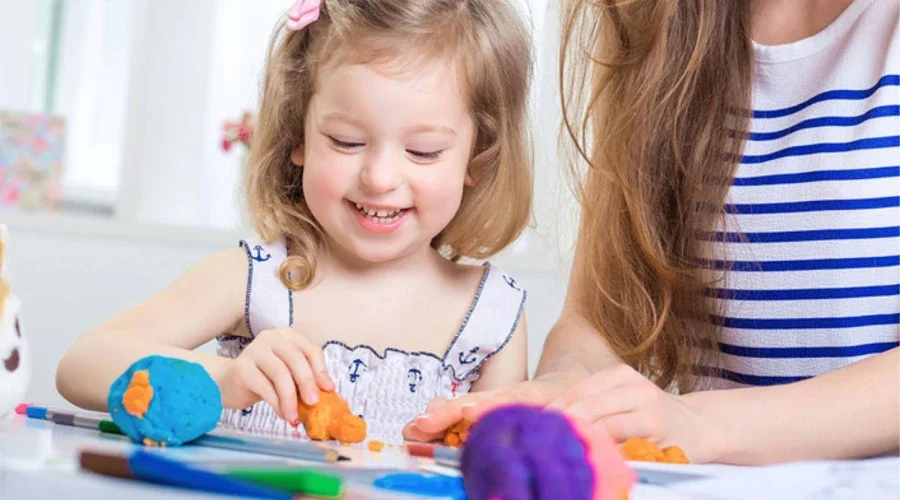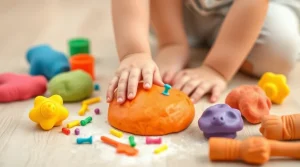
What Is Sensory Education in Montessori?
A complete guide to Montessori sensory education—how it refines perception, builds focus, and supports early development.
#1 Toys Manufacturer in China. WhatsApp: +86 180-0088-4063. Email: [email protected]
#1 Toys Manufacturer in China. WhatsApp: +86 180-0088-4063. Email: [email protected]

Sensory toys are often linked to autism, but they serve a broader purpose. To understand their value, we need to explore how these tools connect to the human nervous system, especially the way the brain processes sensory input.
Sensory toys are objects designed to stimulate one or more of the five senses: touch, sight, sound, smell, and taste. Some also include movement and balance (vestibular sense) or body awareness (proprioception).
Common examples include fidget spinners, textured balls, sand, slime, and chewable necklaces. These toys vary in form, but all offer feedback to the brain based on how they are handled or observed.
Different sensory toys target different systems. For example, a stress ball offers tactile feedback, while a spinning toy stimulates the visual and vestibular systems. The goal is to help the brain process information more smoothly.
For some users, sensory input can be overwhelming. For others, it may feel lacking. Toys can help balance both extremes. A child who seeks deep pressure might enjoy weighted toys, while one who is sound-sensitive might benefit from soft music toys.
Sensory integration is the brain’s ability to take in, organize, and respond to information from the senses. When this process is smooth, it helps with learning, attention, and coordination.
According to Dr. A. Jean Ayres, an occupational therapist and neuroscientist who first studied sensory integration in the 1970s, this process is key to how we experience and interact with the world.
In some people—especially those with autism or ADHD—this system functions differently. But sensory integration plays a role in everyone’s development. Sensory toys provide ways to test, train, or soothe this system through everyday play.
Sensory toys are widely recognized in autism support circles, but this connection can sometimes cause confusion. Understanding the link helps clarify their broader purpose.
Children on the autism spectrum often have unique sensory processing needs. They may be hypersensitive to noise, light, or texture—or they may seek more sensory input than neurotypical peers.
Toys that provide consistent sensory input, like squishy putty or noise-canceling headphones, help create comfort and focus. These tools meet specific sensory needs, which is why they are so common in autism interventions.
Sensory integration therapy became popular in the 1980s and 1990s as part of occupational therapy for autism. Many therapists began using weighted vests, swings, and tactile toys during sessions.
These tools helped children calm down or become more alert. As this practice became more widespread, the public started associating all sensory toys with autism therapy, even though their applications are broader.
One common myth is that sensory toys are only for children with a diagnosis. In fact, these tools can benefit anyone—children, teens, and even adults—who need to regulate emotions, stay focused, or simply enjoy sensory play.
Labeling them as “just for autism” can limit access and create stigma. It’s important to understand that sensory needs are universal, though they may vary widely from person to person.
While sensory toys are helpful for individuals with autism, their benefits extend far beyond. Many people enjoy or rely on sensory input for learning, comfort, or focus.
All children explore the world with their senses. Babies chew, toddlers touch everything, and older kids love slime or kinetic sand. This kind of play helps the brain learn.
Sensory toys like textured balls, sand trays, and light-up items give neurotypical kids a way to explore safely. They can calm down with soft textures or get energized by movement-based toys.
Children with ADHD may fidget, pace, or chew pencils. Sensory toys provide a safe outlet for this energy. Weighted lap pads or silent fidgets help with focus in class.
Kids with anxiety may feel calmer when holding something soft or watching bubbles in a tube. Sensory Processing Disorder (SPD) also benefits from these tools, much like autism.
Adults use sensory items too—stress balls at work, weighted blankets at night, or aromatherapy diffusers. These tools reduce stress and support mental focus.
Seniors may use textured mats or soft fabrics to stimulate memory or soothe dementia-related agitation. Sensory needs and responses don’t disappear with age.
Sensory play isn’t just fun—it’s rooted in brain science. Every time we squeeze, smell, or spin a sensory toy, the brain is processing that data and adjusting its responses.
When you touch something soft or watch something swirl, several parts of your brain become active—like the somatosensory cortex (touch), occipital lobe (vision), and cerebellum (movement).
These areas work together to form a full sensory picture. The better these systems talk to each other, the smoother our reactions and behaviors.
Pleasant sensory play can release dopamine, the brain’s “feel good” chemical. Repeating actions, like squishing dough or clicking a fidget, can also lower cortisol, the stress hormone.
>> Play With Clay: What Clay is Best for Kids
That’s why sensory toys are often soothing. They help the nervous system regulate itself naturally through feedback loops.
When people are overstimulated or anxious, sensory input can help calm them. Weighted items give pressure. Rhythmic movement gives predictability. Both tell the brain it’s safe.
This is why many sensory toys help with self-soothing—not just for children but for anyone who needs a moment of sensory peace.
Sensory play builds more than just calm. It supports physical, cognitive, and emotional growth—especially in the early years.
Using putty, threading beads, or squishing sand builds hand strength and control. These activities develop the fine motor skills needed for writing, tying shoes, and more.
Hand-eye coordination also improves as kids learn to reach, grasp, and manipulate small items. These are foundational skills for daily life.
Toys that keep hands busy can help kids stay focused in class. The movement gives their brains something to do, without being too distracting.
Sensory toys also give children tools for calming down after stress. Squeezing, chewing, or rubbing soft textures can help them reset emotionally.
Young children learn through play. Sensory toys add texture and movement to that play, making lessons more engaging and memorable.
For example, a child might learn about volume by pouring water, or about texture by comparing soft and rough fabrics. These experiences connect the physical and mental worlds.
Sensory toys are now a familiar sight beyond therapy rooms. Their role in promoting calm, focus, and engagement makes them useful across schools, clinics, and mental health spaces.
Teachers are increasingly using sensory tools to support attention and behavior in class. Simple fidgets, textured strips on desks, or quiet putty can help students stay engaged without disrupting others.
These tools are especially useful during transitions, tests, or group activities. They offer a physical outlet for energy and anxiety, helping students return to tasks with more focus.
Occupational therapists use sensory tools with many populations—not just children with autism. These tools support motor planning, regulation, and attention in kids recovering from injury, managing ADHD, or adjusting to developmental delays.
Therapists may recommend balance boards, swings, or oral motor toys based on a child’s specific needs. The goal is always to support skill-building and independence through engaging, regulated play.
Sensory input can deeply affect emotional regulation. In therapy, tools like weighted blankets, calming visuals, or textured objects may be used to ground clients during sessions.
People with anxiety, PTSD, or sensory sensitivities often benefit from tactile and movement-based tools. These items help the nervous system stay present and regulated during difficult emotions.
In a fast-paced world, sensory toys offer simple, effective ways to reconnect with the present moment. They’re not just for kids—they can benefit teens and adults too.
>> Slime Without Borax: An Educational Toy Good for Kids?
Teens facing school stress and adults managing work demands often turn to sensory tools for relief. Items like fidget cubes, therapy dough, or textured bracelets offer discreet, soothing input.
For people with anxiety, these tools can be calming companions in meetings, classrooms, or social situations—helping them stay grounded without drawing attention.
Offices are embracing fidget-friendly policies as awareness grows. Quiet spinners, stress balls, or silicone poppers help employees manage restlessness or focus fatigue.
Used properly, these tools can improve productivity and reduce burnout. They’re a healthy alternative to zoning out or reaching for phones during lulls in focus.
Repetition is central to many mindfulness practices. Spinning, squeezing, or rocking motions can promote a meditative state—especially when paired with breathwork or calming environments.
Sensory toys support mindful play, encouraging users to slow down, notice textures or movements, and self-regulate through physical input.
Despite growing popularity, sensory toys still carry misconceptions. These myths can limit access and reinforce stigma—especially for adults or neurodivergent individuals.
The early use of sensory toys in autism therapy led to the widespread belief that they are “medical tools.” While true in part, this narrative overlooks how universal sensory needs are.
Just as glasses support vision for many, sensory toys support focus or comfort for a wide range of people—regardless of diagnosis.
Some people hesitate to use sensory tools in public due to fear of judgment. This stigma stems from misunderstanding what these tools are for.
In reality, sensory toys are used quietly and respectfully by people of all ages and needs. Normalizing them as part of everyday wellness helps reduce shame and increases access.
Like ramps or subtitles, sensory toys are part of universal design—products made to include as many people as possible. Play spaces and classrooms that include sensory tools are more welcoming to all children, not just a few.
Inclusive design isn’t about singling out differences—it’s about giving everyone tools to thrive.
With so many sensory products available, choosing the right one depends on goals, preferences, and environments. Matching toy features to needs ensures they’re both enjoyable and effective.
Each sensory tool supports a different type of input. Need calming? Try soft textures or slow-moving visuals. Need alertness? Go for bumpy textures or bright colors.
Start with what the person seeks—more input, less input, or a specific kind—and test different tools in small, low-stress settings.
>> Air Dry Clay Crafts to Make with Your Kids
A toy doesn’t have to be age-labeled to be useful. An adult may love a toy designed for toddlers if it gives the right sensory feedback.
Still, safety matters. Chewable items should be non-toxic, toys should match hand size, and movement-based tools should fit the user’s strength and coordination level.
Whether at home, school, or work, sensory play works best when it’s accepted and safe. A classroom that welcomes quiet fidgeting or a workplace with a sensory room helps everyone feel more supported.
Inclusivity means offering choices and respecting different needs—not making assumptions about who should or shouldn’t use these tools.
Sensory toys are far more than tools for autism—they support people of all ages and abilities. By engaging our senses, these toys help improve focus, calm, and development across diverse settings. Embracing sensory play unlocks benefits that everyone can enjoy and learn from.
Yes, sensory toys can support social skills by encouraging cooperative play and communication. When children share or explore toys together, they learn to take turns, express feelings, and develop empathy in a natural way.
Absolutely. Many adults find sensory toys like stress balls, fidget spinners, or textured objects helpful for managing anxiety. These toys provide calming sensory input that can reduce nervous energy and improve concentration during stressful situations.
Sensory toys provide controlled sensory input that can help children with SPD regulate their reactions to stimuli. For example, weighted toys provide calming deep pressure, while chewy toys help with oral sensory needs, supporting better daily functioning.
Yes, sensory toys are increasingly used in classrooms to help students focus and manage sensory needs. Items like fidget tools or textured cushions allow kids to stay attentive and calm without disrupting the learning environment.
Cleaning depends on the toy type, but most can be wiped down with mild soap and water or disinfectant wipes. Regular cleaning prevents germs, especially for toys used frequently or shared among children, ensuring safe and hygienic play.
More Related...

A complete guide to Montessori sensory education—how it refines perception, builds focus, and supports early development.

Educational toys unlock creativity, problem-solving, and sensory skills—find out why they matter for every growing child.

From calming stress to building skills, see how sensory toys help children develop focus, creativity, and confidence through hands-on play.

What’s the best toy for child development? Learn how sensory toys shape young minds and bodies in early learning stages.

Our team will answer your inquiries within 48 hours.
Copyright © 2025 GuangDong AKIA Technology Co,. Ltd. All Rights Reserved